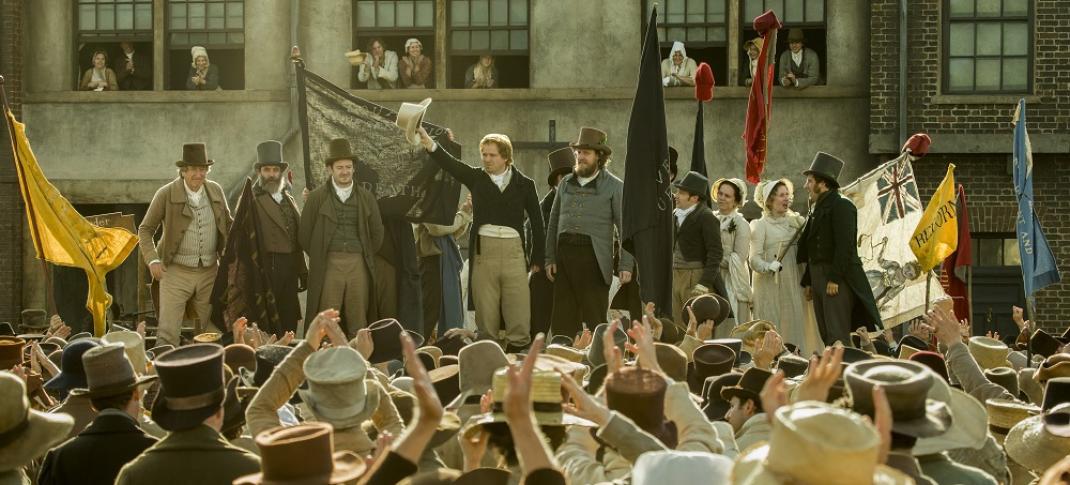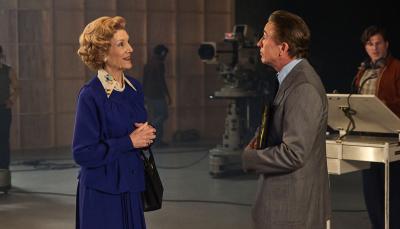The History Behind Mike Leigh's Movie 'Peterloo'

[I] looked in the direction whence the noise proceeded, and saw a party of cavalry in blue and white uniform, come trotting sword in hand, around the corner of a garden wall, and to the front of a row of new houses, where they reined up for a line.
...On the cavalry drawing up they were received with a shout, of good will, as I understood it. They shouted again, waving their sabres over their heads, and then, slackening rein, and striking spur into their steeds, they dashed forward, and began cutting the people.
Passages in the Life of a Radical by Samuel Bamford (1788-1872)
Mike Leigh’s movie Peterloo is officially on release in the U.S. this month, after quickly coming and going from theaters last year (an early release to qualify for European film awards, and then a re-release to coincide with this major anniversary year of the incident).
August 16, 2019 marks the 200th anniversary of a bloody massacre that ended a peaceful political rally in St. Peter’s Field, Manchester, ironically named Peterloo after the infamous Battle of Waterloo (1815). It’s a major event in the history of the city and in the country’s slow journey toward democracy.
Sixty thousand people marched into the city that day to hear speakers, including the celebrity radical Henry Hunt. They were textile workers from all over the Manchester area who were suffering greatly from the chaos that resulted after the end of the Napoleonic Wars. Too many industries connected with the war effort suddenly had no market and wages dropped while food prices rose. To make matters worse, the Prince Regent was wildly unpopular for both his profligate spending (financed by Parliament) and his indifference to his subjects.
Attempts to form trade unions were brutally suppressed. Only about 3% of the population had the vote and were therefore qualified to run for office, restricted to the aristocracy and other men who owned land. Great industrial cities like Manchester and Liverpool had evolved from small communities with little or no representation. But represented areas included rotten boroughs like Old Sarum, which returned two members of Parliament despite being uninhabited; and pocket boroughs, which were traded among aristocratic families and cronies. The elections themselves were unruly and corrupt.
Yet, the class that had all the power in Georgian England was scared by the French revolution: could it happen here? England’s declaration of war on France was as much a message to its own subjects as to the French, and that war raged, more or less, for two decades. The movement for Parliamentary reform—universal suffrage, equal representation, regular elections—was seen as being on a par with the installation of a guillotine. Worse, women were involved!

Carlile’s engraving (above) clearly shows a woman on the hustings —Mary Fildes, President of the Manchester Female Reform Society. Mary was injured in the cavalry attack, but went on to become an early suffragette and was involved in the Chartist movement (which you may remember from Victoria). Women were accustomed to voting at radical gatherings and were consequently displayed in political cartoons as drunk, half-undressed harridans.
In the summer of 1819 Manchester mill owners and magistrates were extremely nervous about the upcoming gathering. It wasn’t the first event of its sort, nor the first time that Henry Hunt had spoken in the city, but rumor had it that participants were performing military drills in preparation. According to weaver Samuel Bamford, a great deal of thought went into crowd control and communication, with a bugle used to give directions and a hierarchy of leaders recognized by the laurel branches they carried. Weapons were not allowed. Everyone dressed in their best; it was a beautiful summer’s day and entire families attended with many politically active women proudly dressed in white.
Bamford describes how his group included a band and people sang and danced as they marched into the city. They carried banners, with slogans like Unity and Strength, Liberty and Fraternity, and Suffrage Universal, and poles topped with red Phrygian caps, a potent symbol of both the French and American revolutions.
Expecting trouble, the city’s magistrates and industrial magnates ordered in three hundred special constables, plus local militia of the Manchester Yeomanry Cavalry, a contingent from the British Army (The King’s Hussars), and artillery. St Peter’s Fields was an open area about a mile from the industrial heart of the city, surrounded by modern and expensive houses. You can see a map with an overlay of the area as it is now here.
No one is quite sure how or why the order to break up the crowd was given. One of the magistrates observing activities from the upstairs of a nearby house may have read the Riot Act (a formal statement asking the crowd to disperse), but it is doubtful whether he would have been heard. The local militia, most of whom were drunk, were the first to attack; the first casualty was a two-year-old child knocked from his mother’s arms. In the space of a few minutes over six hundred people were injured and possibly as many as fifteen killed. It was discovered later that the militia had sharpened their swords in preparation.
In ten minutes from the commencement of the havoc the field was an open and almost deserted space. The sun looked down through a sultry and motionless air. The curtains and blinds of the windows within view were all closed.
The hustings remained, with a few broken and hewed flag-staves erect, and a torn and gashed banner or two dropping; whilst over the whole field were strewed caps, bonnets, hats, shawls, and shoes, and other parts of male and female dress, trampled, torn, and bloody. (Bamford)
To learn more, the People’s History Museum in Manchester has an exhibit, Disrupt? Peterloo and Protest, until early 2020 and there’s lots of information online if you’re not planning a trip. The University of Manchester maintains the Peterloo Collection of contemporary documents, and there's additional information at The Peterloo Memorial Campaign and The Peterloo Massacre. If you'd like to read a fictional account of a contemporary election, there's one in Middlemarch by George Eliot.
Will you go to see the movie Peterloo? And had you heard of the massacre before the movie?



